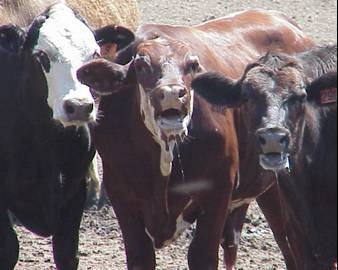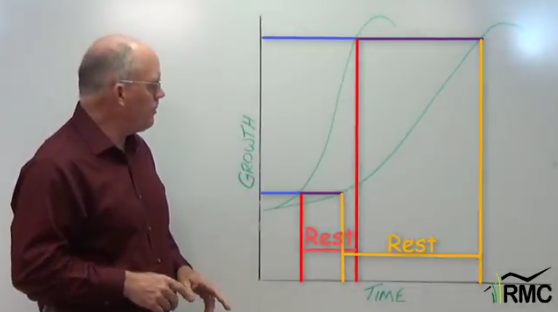 In business, nothing happens until somebody sells something. That’s what makes everything go. It could be a calf, a car, a crop or an idea. If there is competition for a pasture you want to lease, you have to sell yourself as a responsible tenant to the owner. If you are looking for a job, you need to sell your time and talent to an employer. We are selling all of the time.
In business, nothing happens until somebody sells something. That’s what makes everything go. It could be a calf, a car, a crop or an idea. If there is competition for a pasture you want to lease, you have to sell yourself as a responsible tenant to the owner. If you are looking for a job, you need to sell your time and talent to an employer. We are selling all of the time.
Selling is an essential part of business. In spite of its importance, most of us feel uncomfortable selling. At one of our Executive Link meetings I asked members how they felt about selling. Most members told me that selling made them feel nervous, awkward, and uncomfortable. They didn’t want to impose on people or be perceived as pushy.
At one time I shared these misgivings. I held the stereotypical image of a high pressure salesman…the kind of person who “could sell ice to Eskimos.” I didn’t want to be that person.
So Let’s Solve Problems Instead
While most of us don’t like selling, we do like helping people. If we can help someone solve a problem, we feel good and so do they. It is the classic win-win.
Selling is simply a process of helping someone solve a problem. The first step in this process is to view the thing you are selling in terms of the problems it solves. For example:
• A truck load of your calves may solve a feedlot owner’s problem of excess capacity.
• Renting a pasture from someone may solve the problem they’ve had of having unreliable tenants that haven’t taken care of the place.
• Selling a used piece of equipment may solve the problem of the enormous expense of new machinery for someone who is strapped for cash.
• Selling a different production schedule to the management team might be one way of solving the economic and financial problems the business faces.
The Teeter-Totter Theory
Imagine a Teeter Totter. On one side there’s a child. On the other side is a 900 pound gorilla. Obviously the teeter totter is going to tip toward the gorilla.
Selling is the job of tipping the teeter-totter. On one end of the teeter-totter is the cost of someone’s problem. At the other end is the cost of your solution. If the cost of the solution is greater than the cost of having the problem, the teeter- totter won’t budge and you won’t make the sale.

If the cost of having the problem and the value of solving the problem is greater than the cost of your solution you’ll make the sale.

Money Isn’t The Only Cost
Ranching For Profit alumnus and Executive Link member, Tom McGrady, told me he looks at three things when it comes to costs and benefits: Time, Energy and Money. I think it is useful to consider these three things when it comes to our teeter-totter sales model.
People expressing interest in the Ranching For Profit School usually recognize that the financial value of the insights they will gain and the tools they will learn far out weigh the tuition. However, this may not be enough to tip the teeter-totter toward attending. The cost of the solution includes the cost of spending a week away from home and the emotional cost of dealing with the issues they know they will be confronting at the school. To overcome these costs of attending, they must recognize the cost of maintaining the status quo and the value of the solutions in terms of time, money and emotional energy.
Focus on the Buyer’s Needs
In the continuing education program at the last Executive Link (EL) meeting, members were given imaginary products to try to sell to one another. One of these products was a high volume, portable, inexpensive pump that can be used to pull water out of creeks and dugouts to fill tanks and troughs. I watched one EL member work as hard as he could to make the sale. He enthusiastically outlined the features and benefits. Five minutes into the sales pitch the potential buyer said, “But I don’t have any surface water to pump.”
Selling ice to Eskimos, or a pump to someone who doesn’t have a need for one, violates one of the fundamental tenets of selling. Diagnose before you prescribe. (This is also habit #4 in the 7 Habits of Highly Effective people course we teach.) You are wasting your time and the buyer’s time if you try to sell something to someone who doesn’t need what you have.
There are two steps in the diagnosis process: learn to ask questions and listen to the answers. Mastering the second step must come first since it doesn’t do any good to ask questions if we don’t listen to the answers.
Listening
Jill Rigney is an Australian colleague of mine who teaches a terrific course called 7/8th Selling. Jill says that while the average person speaks at 150 words/minute the average person has the capacity to listen at 400 words/minute. Meanwhile, our minds can process 1,200 frames of information each second! Is it any wonder we have a hard time staying focused on what someone is saying, and why they have a hard time staying tuned into what we are talking about? Jill says that ten to twelve words into a conversation we are usually starting to form our response or are being distracted by one of the other 1,199 things our mind is picking up on. Either way we have stopped effective listening.
Successful Sale
 A large part of the 7/8th Selling course is devoted to learning to listen more effectively. They teach empathic listening. (This is a skill we also teach in our 7 Habits of Highly Effective People course and in Executive Link.) Empathic listening is listening with the intent to understand rather than respond. When listening empathically, we focus on the message, occasionally reflecting back our understanding without questioning, judging or advising.
A large part of the 7/8th Selling course is devoted to learning to listen more effectively. They teach empathic listening. (This is a skill we also teach in our 7 Habits of Highly Effective People course and in Executive Link.) Empathic listening is listening with the intent to understand rather than respond. When listening empathically, we focus on the message, occasionally reflecting back our understanding without questioning, judging or advising.
We’ve all had the frustration of feeling misunderstood, or having our problems trivialized when someone says, You think that’s bad? Let me tell you about what happened to me! When you listen for deep understanding, it gives others psychological air (another term we use in the 7 Habits course). In other words, when you can’t breathe, all you can think about is getting your next breath. If we don’t feel understood, it can feel like we are suffocating. We don’t want sympathy. We don’t want solutions. We don’t want to hear someone else’s story. We don’t want to be judged. We just want to be understood. When someone finally does understand, it is like finally getting some fresh air. Effective sales people know how to listen to understand.
Only about 45% of communication is verbal, and the actual words we use are only a small fraction of that. Try saying “Great!” enthusiastically. Now say it as though you just found out that your neighbor’s bulls got through the fence, the landlord is raising the rent 20% and you just got a notice that you are being audited by the IRS. Do you see how the same word can have two completely different meanings? Equally important, notice how your body involuntarily contributes to the message with raised eyebrows, or an upward eye roll and the shrug of your shoulders. When you listen, listen to the entire message people are delivering, with your ears and your eyes.
The key to learning to listen effectively is simply becoming aware of when you are not listening effectively. When you realize that you are forming a response while the other person is still talking or that you are becoming distracted by something, refocus your energy on listening to understand.
The next important step is “Questioning.” We’ll cover that next week in Part 2 of this series.




